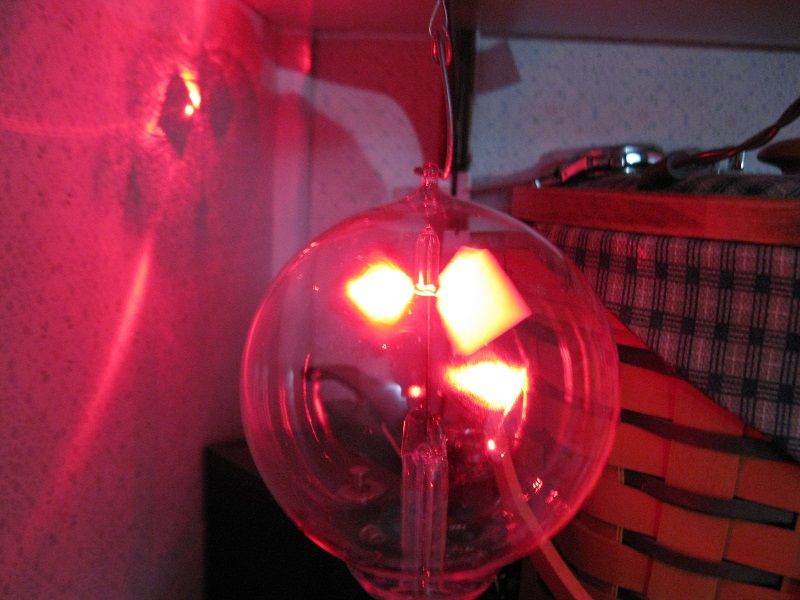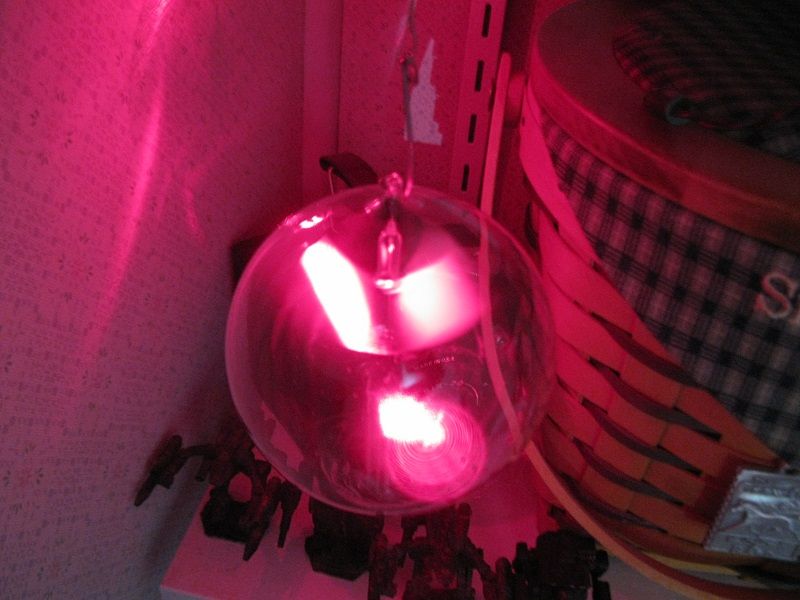- Joined
- Nov 2, 2012
- Messages
- 626
- Points
- 43
I was pointing lasers around and noticed my Crooke's radiometer that I've had since I was a kid. Aimed some lasers at it and if there was enough power, the radiometer would start turning. More power and it turns faster! I had to hit the black side of the diamonds with ~100mW to move the rotor, but it wouldn't stay turning at that speed; it stopped as soon as the diamond moved out of the beam, and before the next diamond entered it. At ~200mW I could get it to turn most of the time, and at 300mW it turns reliably. At ~500mW (using my 200mW and 300mW red lasers) it was turning very fast, and with much more than that the rotor would probably start to wobble due to the fast rotation. I didn't test my 1W 808nm on it because I don't have safety goggles for that and the radiometer DOES produce reflections. Not a big problem, but goggles are highly recommended in trying this with anything high-power.
I'm making the basic assumption that all wavelengths are absorbed equally as the surface is black, but of course that might not be true.
I wasn't able to get it turning the other way via hitting the white side; I don't have nearly enough laser power on hand for that. I imagine it could be done with a 2W or so laser. Feeling a bit lazy atm but maybe I should load all of my lasers onto the chemistry stand and see if I can drive it via the white side.
It works best if the laser is aimed at the farthest point from the central spindle so as to exploit the leverage, and it definitely helps if the beam is diverged out a bit so as to illuminate more of the rotor face. Avoid focusing to a point; it will definitely burn the paint. High power lasers would best be aimed at the white side instead of the black, or else they should be diverged to a larger spot.
Very crude of course, in terms of accuracy and whatnot, and it will not give a definite number. But for those without an LPM it does work in comparing the relative power of different lasers. A calibration of sorts can be done if using a laser of known power.
For lasers under 200mW, which will not drive the rotor reliably, one can simply drive it with a higher power laser, and then add the lower power laser to it and observe the change in rotation speed.
Since Cheech's laser metered at 200mW and the Lazerer blue metered at 127mW (according to Max's power certificate) I went ahead and used those as my initial calibration standards. Later I added in the Skylaser 520nm ~50mW, since as far as I've seen in people's sigs these were pretty much on-spec at the time of Offroadfreaks second Skylaser group buy. The PL520 diode was very new and expensive at the time and I suspect that's why.
Some results:
I aimed a laser of 200mW and 127mW (Cheech's 638nm and Lazerer's LZCS 450nm, respectively) and observed the rotation speed. Then I compared it to LaserBTB's "300mW" 650nm alone. The Skylaser drove it faster than the other two lasers, so it would appear that the Skylaser is emitting more than 327mW. Cool, overspec!
Then, I drove the radiometer with Cheech's laser plus my 50mW Skylaser. Then swapped the Skylaser for a 405nm ebay SD-303. The rotor turned faster with the ebay pen, so it appears that the ebay pen puts out more than 50mW. However, it still ran slower than with the 450nm Lazerer. So, the ebay pen appears to put out less than 127mW.
Finally, I compared the 200mW 638nm alone to the SD-303 and the Lazerer combined. It ran faster when driven by the 405 and 450 than it did with the 638, which metered at 200mW. I know that the Lazerer is 127mW, so the 405 must be putting out more than 73mW. If I had other lasers of known power, I could get closer to the actual number.
The whole thing depends on the assumption being true that the black faces on the diamonds have equal absorbance, and it also depends on consistent placement of the laser spots and the spot size being the same.
Lastly, the whole thing just looks really cool in operation If you have a Crooke's radiometer, give it a try and see how it works out! :beer:
If you have a Crooke's radiometer, give it a try and see how it works out! :beer:
ETA: Photos!
638nm @ 200mW:

650nm @ >300mW:

I'm making the basic assumption that all wavelengths are absorbed equally as the surface is black, but of course that might not be true.
I wasn't able to get it turning the other way via hitting the white side; I don't have nearly enough laser power on hand for that. I imagine it could be done with a 2W or so laser. Feeling a bit lazy atm but maybe I should load all of my lasers onto the chemistry stand and see if I can drive it via the white side.
It works best if the laser is aimed at the farthest point from the central spindle so as to exploit the leverage, and it definitely helps if the beam is diverged out a bit so as to illuminate more of the rotor face. Avoid focusing to a point; it will definitely burn the paint. High power lasers would best be aimed at the white side instead of the black, or else they should be diverged to a larger spot.
Very crude of course, in terms of accuracy and whatnot, and it will not give a definite number. But for those without an LPM it does work in comparing the relative power of different lasers. A calibration of sorts can be done if using a laser of known power.
For lasers under 200mW, which will not drive the rotor reliably, one can simply drive it with a higher power laser, and then add the lower power laser to it and observe the change in rotation speed.
Since Cheech's laser metered at 200mW and the Lazerer blue metered at 127mW (according to Max's power certificate) I went ahead and used those as my initial calibration standards. Later I added in the Skylaser 520nm ~50mW, since as far as I've seen in people's sigs these were pretty much on-spec at the time of Offroadfreaks second Skylaser group buy. The PL520 diode was very new and expensive at the time and I suspect that's why.
Some results:
I aimed a laser of 200mW and 127mW (Cheech's 638nm and Lazerer's LZCS 450nm, respectively) and observed the rotation speed. Then I compared it to LaserBTB's "300mW" 650nm alone. The Skylaser drove it faster than the other two lasers, so it would appear that the Skylaser is emitting more than 327mW. Cool, overspec!
Then, I drove the radiometer with Cheech's laser plus my 50mW Skylaser. Then swapped the Skylaser for a 405nm ebay SD-303. The rotor turned faster with the ebay pen, so it appears that the ebay pen puts out more than 50mW. However, it still ran slower than with the 450nm Lazerer. So, the ebay pen appears to put out less than 127mW.
Finally, I compared the 200mW 638nm alone to the SD-303 and the Lazerer combined. It ran faster when driven by the 405 and 450 than it did with the 638, which metered at 200mW. I know that the Lazerer is 127mW, so the 405 must be putting out more than 73mW. If I had other lasers of known power, I could get closer to the actual number.
The whole thing depends on the assumption being true that the black faces on the diamonds have equal absorbance, and it also depends on consistent placement of the laser spots and the spot size being the same.
Lastly, the whole thing just looks really cool in operation
ETA: Photos!
638nm @ 200mW:

650nm @ >300mW:

Last edited:


